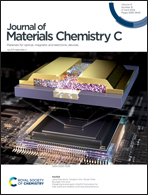Intermolecular lithium bonding between different components upon mixing simultaneously enhances the thermal and electrical properties of an amorphous organic semiconductor material†
Abstract
Amorphous organic materials have various advantages, including lightness, flexibility, and low-cost production, and their industrial value has been widely verified. Nevertheless, unstable thermal properties and relatively poor electrical performance compared to inorganic counterparts result in numerous challenges. Herein, we report simultaneous improvement in the thermal stability and electrical properties of an electron transport material by mixing (3-(dibenzo[c,h]acridin-7-yl)phenyl)di-phenylphosphine oxide with 8-hydroxyquinolinolato-lithium that formed intermolecular lithium bonding between different mixing components. When mixed at a 1 : 1 volume ratio through physical vapor deposition, the increase in the glass transition temperature of the mixed material was ∼25 K higher than theoretical predictions and those of both pristine materials; this unexpected observation has never been reported in systems other than those that form intermolecular hydrogen bonding upon mixing. Simultaneously, the electrical performance examined by the driving voltage of an electron-only device based on these mixed materials shows a similar trend to the thermal property and also exhibits the maximum performance at a 1 : 1 volume ratio of mixing. Spectroscopic and quantum chemistry analyses confirm the formation of intermolecular lithium bonding between different mixing components and the maximum number of lithium bonding complexes is achieved when the material is vapor deposited at the 1 : 1 volume ratio. The strong intermolecular interaction and ionic characteristics of lithium bonding restrict molecular reorientation and increase dipole moment, respectively, resulting in the simultaneous boost in the thermal and electrical properties of amorphous material.



 Please wait while we load your content...
Please wait while we load your content...